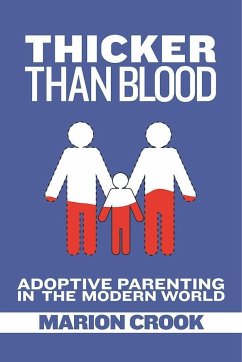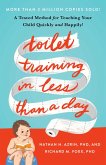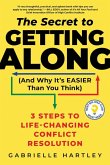17,99 €
inkl. MwSt.
Versandfertig in über 4 Wochen

9 °P sammeln
- Broschiertes Buch
- Merkliste
- Auf die Merkliste
- Bewerten Bewerten
- Teilen
- Produkt teilen
- Produkterinnerung
- Produkterinnerung
A book that explores the nuances and challenges of being an adoptive parent in North America.
Andere Kunden interessierten sich auch für
![Blood Is Not Always Thicker Than Water Blood Is Not Always Thicker Than Water]() Jasmine E. Flmi TurnerBlood Is Not Always Thicker Than Water16,99 €
Jasmine E. Flmi TurnerBlood Is Not Always Thicker Than Water16,99 €![Moms, You Have More POWER Than You Know: How to influence and help your kids launch successfully into young adulthood by elevating and empowering your Moms, You Have More POWER Than You Know: How to influence and help your kids launch successfully into young adulthood by elevating and empowering your]() Wisdom B. FieldsMoms, You Have More POWER Than You Know: How to influence and help your kids launch successfully into young adulthood by elevating and empowering your11,99 €
Wisdom B. FieldsMoms, You Have More POWER Than You Know: How to influence and help your kids launch successfully into young adulthood by elevating and empowering your11,99 €![Special Ed. Blood Sweat Tears I.E.P.'s: Special Education Teachers Administrators Special Ed. Blood Sweat Tears I.E.P.'s: Special Education Teachers Administrators]() Educational Teaching ResourcesSpecial Ed. Blood Sweat Tears I.E.P.'s: Special Education Teachers Administrators8,99 €
Educational Teaching ResourcesSpecial Ed. Blood Sweat Tears I.E.P.'s: Special Education Teachers Administrators8,99 €![Toilet Training in Less Than a Day Toilet Training in Less Than a Day]() Nathan AzrinToilet Training in Less Than a Day16,99 €
Nathan AzrinToilet Training in Less Than a Day16,99 €![The Secret to Getting Along (and Why It's Easier Than You Think) The Secret to Getting Along (and Why It's Easier Than You Think)]() Gabrielle HartleyThe Secret to Getting Along (and Why It's Easier Than You Think)16,99 €
Gabrielle HartleyThe Secret to Getting Along (and Why It's Easier Than You Think)16,99 €![When your heart hurts more than you can imagine When your heart hurts more than you can imagine]() Daniela Winter - MariciWhen your heart hurts more than you can imagine19,99 €
Daniela Winter - MariciWhen your heart hurts more than you can imagine19,99 €![The Blood of Jesus As Our Healer The Blood of Jesus As Our Healer]() Delray Shudark M. A.The Blood of Jesus As Our Healer14,99 €
Delray Shudark M. A.The Blood of Jesus As Our Healer14,99 €-
-
A book that explores the nuances and challenges of being an adoptive parent in North America.
Hinweis: Dieser Artikel kann nur an eine deutsche Lieferadresse ausgeliefert werden.
Hinweis: Dieser Artikel kann nur an eine deutsche Lieferadresse ausgeliefert werden.
Produktdetails
- Produktdetails
- Verlag: Arsenal Pulp Press
- Seitenzahl: 196
- Erscheinungstermin: 21. Juni 2016
- Englisch
- Abmessung: 226mm x 150mm x 15mm
- Gewicht: 363g
- ISBN-13: 9781551526317
- ISBN-10: 155152631X
- Artikelnr.: 43895108
- Herstellerkennzeichnung
- Libri GmbH
- Europaallee 1
- 36244 Bad Hersfeld
- gpsr@libri.de
- Verlag: Arsenal Pulp Press
- Seitenzahl: 196
- Erscheinungstermin: 21. Juni 2016
- Englisch
- Abmessung: 226mm x 150mm x 15mm
- Gewicht: 363g
- ISBN-13: 9781551526317
- ISBN-10: 155152631X
- Artikelnr.: 43895108
- Herstellerkennzeichnung
- Libri GmbH
- Europaallee 1
- 36244 Bad Hersfeld
- gpsr@libri.de
Marion Crook, PhD, is the author of twenty-one previous books which include novels and nonfiction books for both adults and young people, on such subjects as women s health, teen suicide, and body image. She is an adoptive parent and lives on the Sunshine Coast of British Columbia."
Preface
Chapter One How the practice of adoption evolved
Early days to the 20th century
The notion of adopted children as lower class
Adoption and the changing law
The concept of secrecy
The promotion of inter-racial adoption
The Big Scoop and the residential schools for Aboriginal children
The resistance to inter-racial adoption
In Aboriginal communities
In Black communities
Matching children to parents
No more secrecy
Chapter Two The changing world of adoption
The 21st century
Open adoption. Including the birth parents
Types of adoption
Adoption process
Role of government agencies
Role of the birth mother in placement
Transracial placements. Placement of First Nations/Native American children
Affiliation with organizations
Affiliation with cultural groups and role models and the rise of focused
organizations e.g LGBTQ families
Greater understanding of the emotional effect of adoption on adoptees
Post-Traumatic Stress Disorder in adoptees
Abandonment issues as a shared characteristic
Adoptee's relationship with society and effect of celebrity adoptions
Who is adoption serving
Adoption for profit
Importing children for adoption
Notion of "rehoming
Permanence of adoption
Chapter Three Why parents adopt
Desire for a family
Need for the interest, rewards and challenges of family life
Looking for strong emotional bonds expected with children
Diversity of composition, adoption now possible for many
LGBT parents, single parents, grandparents, racially different parents
Confidence in ability to create a family
Belief that adoption will be "as if born to"
Belief that differences of race will be accepted by society
Pressure from religious groups
Commitment to rescuing the "unfortunate"
What motivations serve children best
Chapter Four How capable are adoptive parents
Coping skills of parents
Negative
Denial
Reframing
Rescuing
Rejecting
Positive
Humour
Ability to seek professional advice
Ability to problem solve
Examples of positive adoptive families
What increases the chance of success
Training and education in adoption issues
Strong support system
Patience
Realistic expectations
Chapter Five The impact of adoption on the adoptive family
The Negatives
Parents' fears
Denial of difference
Parental expectations including the illusion of the "perfect family"
Inexperience
Financial costs
Stress on marital relationship
The Positives
The joy of family
Belief in love and money
The development of love and bonding
The pleasure of participating in the world of a child
The blossoming of the marital relationship
Chapter Six The needs and challenges of adoptees through the ages and how
parents can help-- Overview
Generally
What adoptees need
What children notice
Common issues, including abandonment
Recognizing the child's feelings of alienation
What parents can do to assist their children through the ages
Provide information
Anticipate developmental needs
Make connections
Give love
Establish a defined position in the family
Keep them close
Understand the relationships of boys and the adoptive mother
Understand need for fathers
Deal with their own sense of failure, of not being a good enough parent
Chapter Seven The needs and challenges of adoptees through the ages and how
parents can help-Specific ages
Specifically
What are the common concerns of adoptees through their ages and stages
Baby and Toddler
Elementary School Child
Teen
Young Adult
Chapter Eight Search and reunion
Available search possibilities
How do adoptive parents feel
How can they help
How to know what is best for your family
What results can you anticipate
Chapter Nine The Future
Increasing diversity of adoption family
Increasing cultural interactions
Changing searching methods
Practice of adoption agencies
Challenges to family coherence
Need for greater understanding of the early trauma of adoption
Trends, nationally and internationally
Chapter One How the practice of adoption evolved
Early days to the 20th century
The notion of adopted children as lower class
Adoption and the changing law
The concept of secrecy
The promotion of inter-racial adoption
The Big Scoop and the residential schools for Aboriginal children
The resistance to inter-racial adoption
In Aboriginal communities
In Black communities
Matching children to parents
No more secrecy
Chapter Two The changing world of adoption
The 21st century
Open adoption. Including the birth parents
Types of adoption
Adoption process
Role of government agencies
Role of the birth mother in placement
Transracial placements. Placement of First Nations/Native American children
Affiliation with organizations
Affiliation with cultural groups and role models and the rise of focused
organizations e.g LGBTQ families
Greater understanding of the emotional effect of adoption on adoptees
Post-Traumatic Stress Disorder in adoptees
Abandonment issues as a shared characteristic
Adoptee's relationship with society and effect of celebrity adoptions
Who is adoption serving
Adoption for profit
Importing children for adoption
Notion of "rehoming
Permanence of adoption
Chapter Three Why parents adopt
Desire for a family
Need for the interest, rewards and challenges of family life
Looking for strong emotional bonds expected with children
Diversity of composition, adoption now possible for many
LGBT parents, single parents, grandparents, racially different parents
Confidence in ability to create a family
Belief that adoption will be "as if born to"
Belief that differences of race will be accepted by society
Pressure from religious groups
Commitment to rescuing the "unfortunate"
What motivations serve children best
Chapter Four How capable are adoptive parents
Coping skills of parents
Negative
Denial
Reframing
Rescuing
Rejecting
Positive
Humour
Ability to seek professional advice
Ability to problem solve
Examples of positive adoptive families
What increases the chance of success
Training and education in adoption issues
Strong support system
Patience
Realistic expectations
Chapter Five The impact of adoption on the adoptive family
The Negatives
Parents' fears
Denial of difference
Parental expectations including the illusion of the "perfect family"
Inexperience
Financial costs
Stress on marital relationship
The Positives
The joy of family
Belief in love and money
The development of love and bonding
The pleasure of participating in the world of a child
The blossoming of the marital relationship
Chapter Six The needs and challenges of adoptees through the ages and how
parents can help-- Overview
Generally
What adoptees need
What children notice
Common issues, including abandonment
Recognizing the child's feelings of alienation
What parents can do to assist their children through the ages
Provide information
Anticipate developmental needs
Make connections
Give love
Establish a defined position in the family
Keep them close
Understand the relationships of boys and the adoptive mother
Understand need for fathers
Deal with their own sense of failure, of not being a good enough parent
Chapter Seven The needs and challenges of adoptees through the ages and how
parents can help-Specific ages
Specifically
What are the common concerns of adoptees through their ages and stages
Baby and Toddler
Elementary School Child
Teen
Young Adult
Chapter Eight Search and reunion
Available search possibilities
How do adoptive parents feel
How can they help
How to know what is best for your family
What results can you anticipate
Chapter Nine The Future
Increasing diversity of adoption family
Increasing cultural interactions
Changing searching methods
Practice of adoption agencies
Challenges to family coherence
Need for greater understanding of the early trauma of adoption
Trends, nationally and internationally
Preface
Chapter One How the practice of adoption evolved
Early days to the 20th century
The notion of adopted children as lower class
Adoption and the changing law
The concept of secrecy
The promotion of inter-racial adoption
The Big Scoop and the residential schools for Aboriginal children
The resistance to inter-racial adoption
In Aboriginal communities
In Black communities
Matching children to parents
No more secrecy
Chapter Two The changing world of adoption
The 21st century
Open adoption. Including the birth parents
Types of adoption
Adoption process
Role of government agencies
Role of the birth mother in placement
Transracial placements. Placement of First Nations/Native American children
Affiliation with organizations
Affiliation with cultural groups and role models and the rise of focused
organizations e.g LGBTQ families
Greater understanding of the emotional effect of adoption on adoptees
Post-Traumatic Stress Disorder in adoptees
Abandonment issues as a shared characteristic
Adoptee's relationship with society and effect of celebrity adoptions
Who is adoption serving
Adoption for profit
Importing children for adoption
Notion of "rehoming
Permanence of adoption
Chapter Three Why parents adopt
Desire for a family
Need for the interest, rewards and challenges of family life
Looking for strong emotional bonds expected with children
Diversity of composition, adoption now possible for many
LGBT parents, single parents, grandparents, racially different parents
Confidence in ability to create a family
Belief that adoption will be "as if born to"
Belief that differences of race will be accepted by society
Pressure from religious groups
Commitment to rescuing the "unfortunate"
What motivations serve children best
Chapter Four How capable are adoptive parents
Coping skills of parents
Negative
Denial
Reframing
Rescuing
Rejecting
Positive
Humour
Ability to seek professional advice
Ability to problem solve
Examples of positive adoptive families
What increases the chance of success
Training and education in adoption issues
Strong support system
Patience
Realistic expectations
Chapter Five The impact of adoption on the adoptive family
The Negatives
Parents' fears
Denial of difference
Parental expectations including the illusion of the "perfect family"
Inexperience
Financial costs
Stress on marital relationship
The Positives
The joy of family
Belief in love and money
The development of love and bonding
The pleasure of participating in the world of a child
The blossoming of the marital relationship
Chapter Six The needs and challenges of adoptees through the ages and how
parents can help-- Overview
Generally
What adoptees need
What children notice
Common issues, including abandonment
Recognizing the child's feelings of alienation
What parents can do to assist their children through the ages
Provide information
Anticipate developmental needs
Make connections
Give love
Establish a defined position in the family
Keep them close
Understand the relationships of boys and the adoptive mother
Understand need for fathers
Deal with their own sense of failure, of not being a good enough parent
Chapter Seven The needs and challenges of adoptees through the ages and how
parents can help-Specific ages
Specifically
What are the common concerns of adoptees through their ages and stages
Baby and Toddler
Elementary School Child
Teen
Young Adult
Chapter Eight Search and reunion
Available search possibilities
How do adoptive parents feel
How can they help
How to know what is best for your family
What results can you anticipate
Chapter Nine The Future
Increasing diversity of adoption family
Increasing cultural interactions
Changing searching methods
Practice of adoption agencies
Challenges to family coherence
Need for greater understanding of the early trauma of adoption
Trends, nationally and internationally
Chapter One How the practice of adoption evolved
Early days to the 20th century
The notion of adopted children as lower class
Adoption and the changing law
The concept of secrecy
The promotion of inter-racial adoption
The Big Scoop and the residential schools for Aboriginal children
The resistance to inter-racial adoption
In Aboriginal communities
In Black communities
Matching children to parents
No more secrecy
Chapter Two The changing world of adoption
The 21st century
Open adoption. Including the birth parents
Types of adoption
Adoption process
Role of government agencies
Role of the birth mother in placement
Transracial placements. Placement of First Nations/Native American children
Affiliation with organizations
Affiliation with cultural groups and role models and the rise of focused
organizations e.g LGBTQ families
Greater understanding of the emotional effect of adoption on adoptees
Post-Traumatic Stress Disorder in adoptees
Abandonment issues as a shared characteristic
Adoptee's relationship with society and effect of celebrity adoptions
Who is adoption serving
Adoption for profit
Importing children for adoption
Notion of "rehoming
Permanence of adoption
Chapter Three Why parents adopt
Desire for a family
Need for the interest, rewards and challenges of family life
Looking for strong emotional bonds expected with children
Diversity of composition, adoption now possible for many
LGBT parents, single parents, grandparents, racially different parents
Confidence in ability to create a family
Belief that adoption will be "as if born to"
Belief that differences of race will be accepted by society
Pressure from religious groups
Commitment to rescuing the "unfortunate"
What motivations serve children best
Chapter Four How capable are adoptive parents
Coping skills of parents
Negative
Denial
Reframing
Rescuing
Rejecting
Positive
Humour
Ability to seek professional advice
Ability to problem solve
Examples of positive adoptive families
What increases the chance of success
Training and education in adoption issues
Strong support system
Patience
Realistic expectations
Chapter Five The impact of adoption on the adoptive family
The Negatives
Parents' fears
Denial of difference
Parental expectations including the illusion of the "perfect family"
Inexperience
Financial costs
Stress on marital relationship
The Positives
The joy of family
Belief in love and money
The development of love and bonding
The pleasure of participating in the world of a child
The blossoming of the marital relationship
Chapter Six The needs and challenges of adoptees through the ages and how
parents can help-- Overview
Generally
What adoptees need
What children notice
Common issues, including abandonment
Recognizing the child's feelings of alienation
What parents can do to assist their children through the ages
Provide information
Anticipate developmental needs
Make connections
Give love
Establish a defined position in the family
Keep them close
Understand the relationships of boys and the adoptive mother
Understand need for fathers
Deal with their own sense of failure, of not being a good enough parent
Chapter Seven The needs and challenges of adoptees through the ages and how
parents can help-Specific ages
Specifically
What are the common concerns of adoptees through their ages and stages
Baby and Toddler
Elementary School Child
Teen
Young Adult
Chapter Eight Search and reunion
Available search possibilities
How do adoptive parents feel
How can they help
How to know what is best for your family
What results can you anticipate
Chapter Nine The Future
Increasing diversity of adoption family
Increasing cultural interactions
Changing searching methods
Practice of adoption agencies
Challenges to family coherence
Need for greater understanding of the early trauma of adoption
Trends, nationally and internationally







